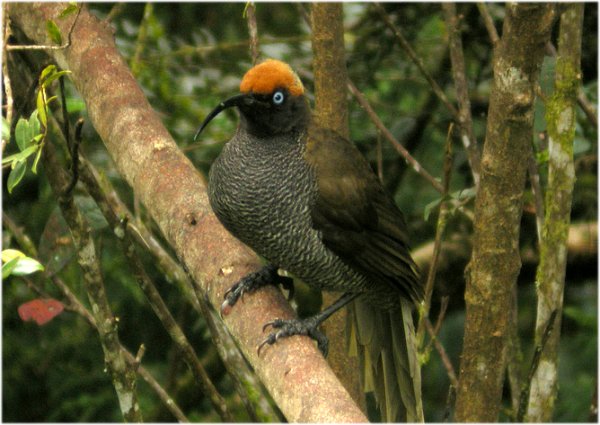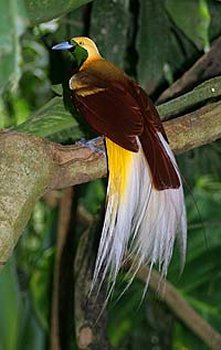Family: Paradisaeidae
Ribbon-tailed
Astrapia, Astrapia mayeri
  Ribbon-tailed
Astrapia, Astrapia mayeri
Ribbon-tailed
Astrapia, Astrapia mayeri
http://en.wikipedia.org/wiki/File:Ribbon-tailed_Astrapia.jpg
Right:
Juvenile male Ribbon-tailed Astrapia, Astrapia mayeri,
yet to develop his white tail plumage
http://en.wikipedia.org/wiki/File:Ribbon-tailed_Astrapia_(Astrapia_mayeri)_juvenile_(male),_cropped.jpg
|
The Ribbon-tailed Astrapia also known as Shaw Mayer's Astrapia,
Astrapia mayeri, is a medium-sized, up to 32 cm
long (without including the tail of the male, which can be over
1 meter), velvet black bird of paradise. The male has an
iridescent olive green and bronze plumage, and is adorned with
ornamental "ball" plume above its bill and two extremely
long, ribbon-like white tail feathers. The female is a brown
bird with an iridescent head. Hybrids between this species
and the Stephanie's Astrapia, in the small area where their
ranges overlap, have been named Barnes' Astrapia.
One of the most spectacular birds of paradise, the male Ribbon-tailed
Astrapia has the longest tail feathers in relation
to body size of any bird, over three times the length of its
body.
The Ribbon-tailed Astrapia is distributed and endemic to subalpine
forests in western part of the central highlands of
Papua New Guinea. Like many other ornamental birds of paradise,
the male is polygamous. The Ribbon-tailed Astrapia
is the latest bird of paradise to be discovered.
The scientific name commemorates the great naturalist and New
Guinea explorer Fred Shaw Mayer, who was believed
to have discovered the bird in 1938. However, it is now believed
that explorer Jack Hides discovered the bird, while
Mayer became interested in it later.
Source: http://en.wikipedia.org/wiki/Ribbon-tailed_Astrapia
Wilson's
Bird-of-paradise, Cicinnurus respublica
 Wilson's
Bird of Paradise
Wilson's
Bird of Paradise
Photo: Serhanoksay
|
The Wilson's Bird-of-paradise,
Cicinnurus respublica, is a small, up to 21 cm long,
passerine bird of the Paradisaeidae
family. The male is a red and black bird-of-paradise with a
yellow mantle on its neck, light green mouth, rich blue feet
and two curved violet tail feathers. The head is naked blue
with black double cross pattern on it. The female is a brownish
bird with bare blue crown.
In the field the blue bare
skin on the crown of the bird's head is so vivid that it is
clearly visible by night, the deep scarlet
back and velvet green breast are lush, and the curlicue tail
gleams bright silver.
An Indonesian endemic, the Wilson's Bird-of-paradise is distributed
to the hill and lowland rainforests of Waigeo and
Batanta Islands off West Papua. The diet consists mainly of
fruits and small insects.
 Wilson’s
bird-of-paradise - overview
Wilson’s
bird-of-paradise - overview
BBC Natural History Unit
www.arkive.org
|
The controversial scientific name of this species was given
by Charles Lucien Bonaparte, Napoleon's nephew and a
republican idealist, who described the bird from a badly damaged
trade specimen purchased by British ornithologist
Edward Wilson. In doing so, he beat John Cassin, who wanted
to name the bird in honor of Wilson, by several months
. Thirteen years later, in 1863, the German zoologist Heinrich
Agathon Bernstein discovered the home grounds of the
Wilson's Bird-of-paradise in Waigeo Island.
Due to ongoing habitat loss, limited range and exploitation,
the Wilson's Bird-of-paradise is evaluated as Near
Threatened on the IUCN Red List of Threatened Species. It
is listed on Appendix II of CITES.
The first footage of the Wilson's Bird-of-paradise ever to
be filmed was recorded in 1996 by David Attenborough for
the BBC documentary Attenborough in Paradise. He did so by
dropping leaves on the forest floor, which irrated the
bird into clearing them away.
King
Bird-of-paradise, Cicinnurus regius
 King
Bird of paradise - male
King
Bird of paradise - male
Photo: Doug Janson
|
The King Bird-of-paradise,
Cicinnurus regius, is a small, approximately 16 cm long,
passerine bird of the Paradisaeidae (Bird-of-paradise)
family. The male is a crimson and white with bright blue feet
and green-tipped fan-like plumes on its
shoulder. The two elongated tail wires are decorated with emerald
green disk feathers on its tip. The unadorned female
is a brown bird with barring below.
The King Bird-of-paradise is distributed throughout lowland
forests of New Guinea and nearby islands. This so-called
"living gem" is the smallest and most vividly colored
among birds of paradise. The diet consists mainly of fruits
and
arthropods.
An extraordinary display is performed by the male with a series
of tail swinging, fluffing of its abdomen white feathers
that makes the bird look like a cottonball, and acrobatic pendulum
displays.
|
Brown
Sickbill, Epimachus meyeri
 A
male Brown Sicklebill in Papua New Guinea
A
male Brown Sicklebill in Papua New Guinea
http://en.wikipedia.org/wiki/File:Epimachus_meyeri_-Papua_New_Guinea_-male-8.jpg
|
The Brown Sickbill, Epimachus meyeri, is a large,
up to 96 cm long, dark blue and green bird-of-paradise with
highly
iridescent plumages, a sickle-shaped bill, pale blue iris
and brown underparts. The male is adorned with ornamental
plumes
on the sides of its rear and a huge sabre-shaped central tail
feathers that are highly prized by natives. The female is
a
reddish brown bird with buff barred black below.
The Brown Sicklebill is distributed to mountain forests of
New Guinea, Its appearance resembles the closely related and
larger Black Sicklebill. In areas where these two large sicklebills
met, the Brown Sicklebill replaced the latter species in
higher altitudes. Its diet consists mainly of fruits, arthropods
and small animals.
This bird was discovered by Carl Hunstein in 1884 and named
after Adolf Bernard Meyer of Dresden Museum, Germany.
 Brown
Sicklebill, female, in Papua New Guinea.
Brown
Sicklebill, female, in Papua New Guinea.
http://en.wikipedia.org/wiki/File:Epimachus_meyeri_-Papua_New_Guinea-8.jpg
|
Twelve-wired
Bird of Paradise, Seleucidis melanoleuca

 Twelve-wired
Bird of Paradise, Seleucidis melanoleuca
Twelve-wired
Bird of Paradise, Seleucidis melanoleuca
Left: Photo: Stavenn , Bronx Zoo, New York
Right; Female, Photo: Doug Janson
|
The Twelve-wired Bird-of-paradise, Seleucidis melanoleucus
or Seleucidis melanoleuca, is a medium-sized,
approximately 33 cm long, velvet black and yellow bird-of-paradise.
The male has a red iris, long black bill and rich
yellow plumes along its flanks. From the rear of these plumes
emerge twelve blackish, wire-like filaments, which bend
back near their bases to sweep forward over the birds hindquarters.
The female is a brown bird with black-barred
buffy underparts. Its feet are strong, large-clawed and pink
in color.
The sole representative of the monotypic genus Seleucidis,
the Twelve-wired Bird-of-paradise is a bird of lowland forests.
The male displays on an exposed vertical perch with its breast-shield
flared. Its diet consists mainly of fruits and arthropods.
Widely distributed throughout New Guinea and Salawati Island
of Irian Jaya, the Twelve-wired Bird-of-paradise has not been
easy to breed in captivity. It has only been successfully
bred in Singapore's Jurong Bird Park.
Lesser
Bird of Paradise, Paradisaea minor
 Lesser
Bird of Paradise, Paradisaea minor
Lesser
Bird of Paradise, Paradisaea minor
Photo: Roderick Eime
|
The Lesser Bird-of-paradise is medium-sized, up to 32 cm-long,
maroon-brown with a yellow crown and brownish-yellow
upper back. The male has a dark emerald-green throat, a pair
of long tail-wires and is adorned with ornamental flank
plumes which are deep yellow at their base and fade outwards
into white. The female is a maroon bird with a dark-brown
head and whitish underparts. Further study is required, but
it seems likely that birds of paradise also possess toxins
in their
skins, derived from their insect prey.
It resembles the larger Greater Bird-of-paradise, but the
male of that species has a dark chest, whereas the female
is
entirely brown (no whitish underparts).
The males are polygamous, and perform courtship displays in
leks. The female usually lays two pinkish eggs with dark
markings in a nest in a tree high above ground. Its diet consists
mainly of fruits and insects.
The Lesser Bird-of-paradise is distributed throughout forests
of northern New Guinea, and the nearby islands
of Misool and Yapen.
|
see red et raggiana |

















